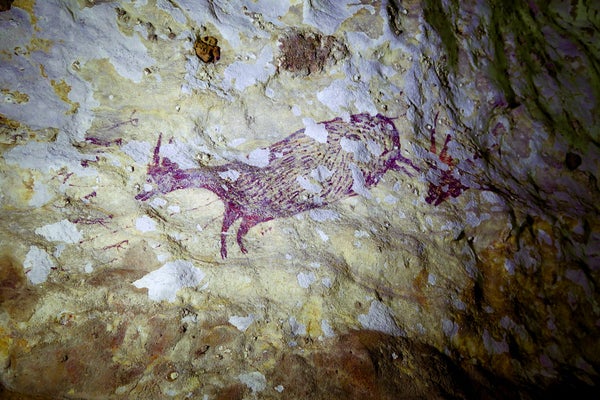In Room 67 of the Prado Museum in Madrid, Francisco Goya’s Saturn enthralls viewers with a scene of abomination.The painting depicts the Greek myth of Cronus (Saturn in the Roman version), who ate his children for fear of being overthrown by them. Critics have interpreted Goya’s rendition—the cannibal god shown wide-eyed with apparent horror, shame and madness as he devours his son—as an allegory of the ravages of war, the decay of Spanish society, the artist’s declining psychological state. It is one of the great narrative artworks of all time. Vanishingly few people attain such mastery of visual storytelling, of course, but even in its lesser forms, such creative expression is special: only our species, Homo sapiens, is known to invent fictional tales and convey them through representational imagery.
Archaeologists have eagerly sought the origins of our distinctive artistic behavior. For a long time the oldest examples of figurative art (as opposed to abstract mark making) and depictions of fictitious creatures all came from sites in Europe dated to less than 40,000 years ago. But in recent years researchers have uncovered older instances of figurative art in Southeast Asia. Now archaeologists working on the island of Sulawesi in Indonesia have found the oldest figurative art to date. In a paper published in December in Nature, Maxime Aubert, Adhi Agus Oktaviana and Adam Brumm, all at Griffith University in Australia, and their colleagues report that the art—a cave painting—appears to show several fantastical human figures hunting real-life animals. If they are right, the find could also constitute the oldest pictorial record of storytelling and supernatural thinking in the world.
An Ancient Scene
On supporting science journalism
If you're enjoying this article, consider supporting our award-winning journalism by subscribing. By purchasing a subscription you are helping to ensure the future of impactful stories about the discoveries and ideas shaping our world today.
The team discovered the ancient painting in 2017 in a cave known as Leang Bulu’ Sipong 4 in southern Sulawesi’s karst region of Maros-Pangkep, a dramatic landscape of jutting limestone towers and cliffs. On the cave’s craggy wall, six tiny hunters confront a large buffalo, brandishing ropes or spears. Nearby, other hunters set on more buffaloes, as well as pigs. The hunters appear humanlike but exhibit mysterious animal traits—one possesses a tail, for instance, and another has a beak. Such human-animal hybrids are called therianthropes (derived from the Greek words for “beast” and “human”), and they are considered to be indicators of spiritual thinking—the bull-headed minotaur of Greek mythology, for example, and the jackal-headed Egyptian god Anubis. The researchers suggest that the various figures—all rendered in a pigment with the color of old rust—are part of the same scene and that it may show a communal hunting strategy known as a game drive, in which prey are flushed from cover and driven toward hunters.
To date the images, the researchers measured the radioactive decay of uranium in mineral deposits that had formed atop them. Sampling deposits from various parts of the scene, the team obtained minimum dates ranging from 43,900 to 35,100 years ago. If the painting is at least 43,900 years old, as Aubert and his colleagues argue, it would best the previous record holder for oldest figurative artwork—a 40,000-year-old painting of a cowlike animal found in a cave in Borneo—by several thousand years. It would also beat the 39,000- to 40,000-year-old Löwenmensch (“lion man”) figurine from Germany, which has long held pride of place as the earliest therianthrope, as well as a 17,000-year-old hunting scene from France’s famed Lascaux Cave.
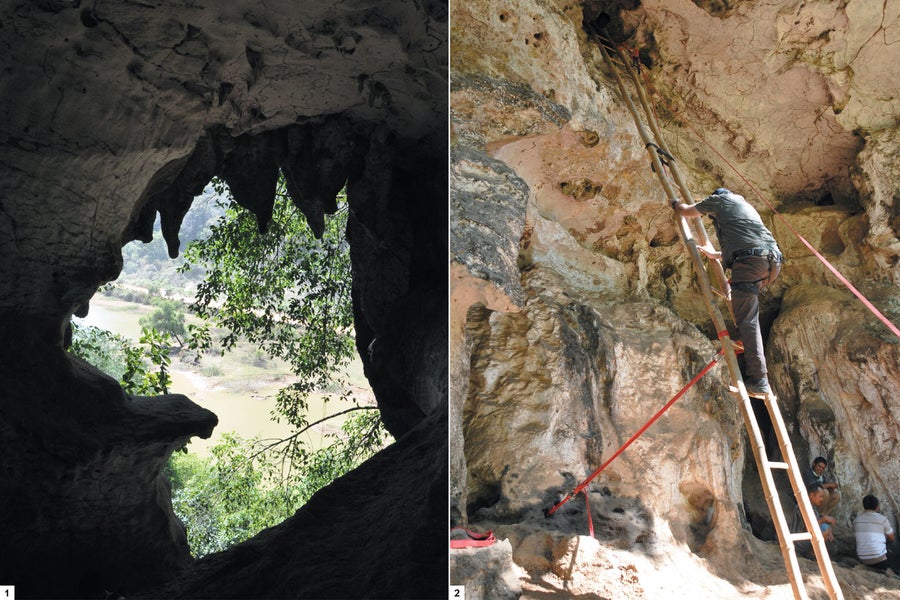
Cave painting was discovered by archaeologists at a site called Leang Bulu’ Sipong 4 on the Indonesian island of Sulawesi (1). The entrance to the cave, located high above the ground, is difficult to access (2). Credit: Kim Newman
The geographic location of the painting is significant. Although experts have long recognized that humans originated in Africa, “Europe was once thought of as a ‘finishing school’ for humanity,” says archaeologist April Nowell of the University of Victoria in Canada, because all the oldest known examples of art and other sophisticated behaviors were found there. But in reality, the pattern of discoveries just reflected the disproportionate amount of archaeological research that was being carried out in Europe, especially in France. “This new discovery adds to an already rich record of early and varied rock art from [Indonesia and Australia] and underscores the importance of conducting research outside Europe,” Nowell says.
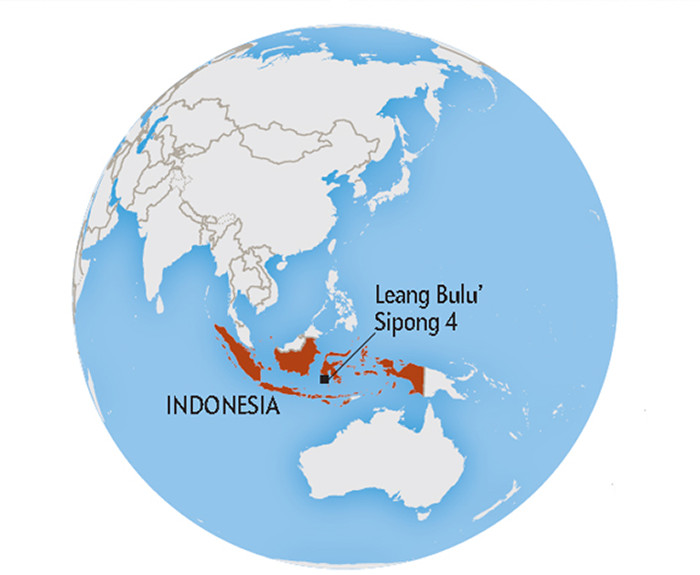
Credit: Mapping Specialists
The position of the newfound painting, in a cave whose entrance some 23 feet above the ground is hard for modern visitors to access without a ladder or climbing equipment, is also intriguing. In Europe, early cave paintings are often found in deep, pitch-dark passages that would have been difficult to get to and work in, which suggests that these places perhaps had special meaning to the artists. Brumm notes that in Sulawesi, ancient images are mostly found near the entrances to caves and rock-shelters, so they occur in the light zone, not the dark one. But as in the case of the Leang Bulu’ Sipong 4 painting, they were created in high, hard-to-reach caves and niches in the region’s limestone towers and cliff faces. “Apart from the art, these sites otherwise show no evidence for human habitation, and we assume ancient people used them just for image making,” Brumm says. “Why, we don’t know. But perhaps creating cave art in such inaccessible, liminal locations high above the ground surface had some sort of deeper cultural and symbolic significance.” He adds that to reach these spots, the artists presumably had to climb up vines or perhaps bamboo poles—or, in some cases, pick their way through the networks of interior cave passages inside the karst towers. But although the ancient artists in Sulawesi and their counterparts in Europe may both have made their creations in places imbued with meaning and used some similar stylistic conventions in portraying their subjects, “any direct historical or cultural connection between the ice age animal art in Indonesia and Europe is unlikely,” Brumm says.
Indeed, although the newly found painting may push back the date for the earliest figurative, therianthropic and narrative art, it reveals little about the driving force behind the emergence of such creative expression. For decades scholars have puzzled over what seems to have been a long lag between the origin of modern human anatomy and modern human behaviors such as creating art. Whereas modern anatomy evolved hundreds of thousands of years ago, the elements of modern behavior—as revealed through the material culture preserved in the archaeological record—coalesced rather later. Some have posited that a late-breaking cognitive shift might have supercharged our ancestors’ powers of ingenuity. Others suppose that cultural, social or environmental factors—or some combination thereof—stoked their creative fires. “This cave art we have dated doesn’t provide any direct insight into this interesting question—sadly!” Brumm says. But in light of the available evidence, he suspects that fictional storytelling arose long before this painting—“perhaps even before our species spread out of Africa.”
The image may also illuminate other aspects of the psyches of our predecessors. “One of the most interesting things about humans is our enhanced working memory,” Nowell explains. “It allows us to plan for the future, sequence events in our minds before enacting them and, of course, tell stories.” She notes that anthropologist Polly Wiessner of the University of Utah has shown that among many contemporary hunter-gatherers, people talk about different things depending on the time of day. During daylight hours they tend to gossip or discuss economic issues or politics. At night, in contrast, they tell stories and sing songs.
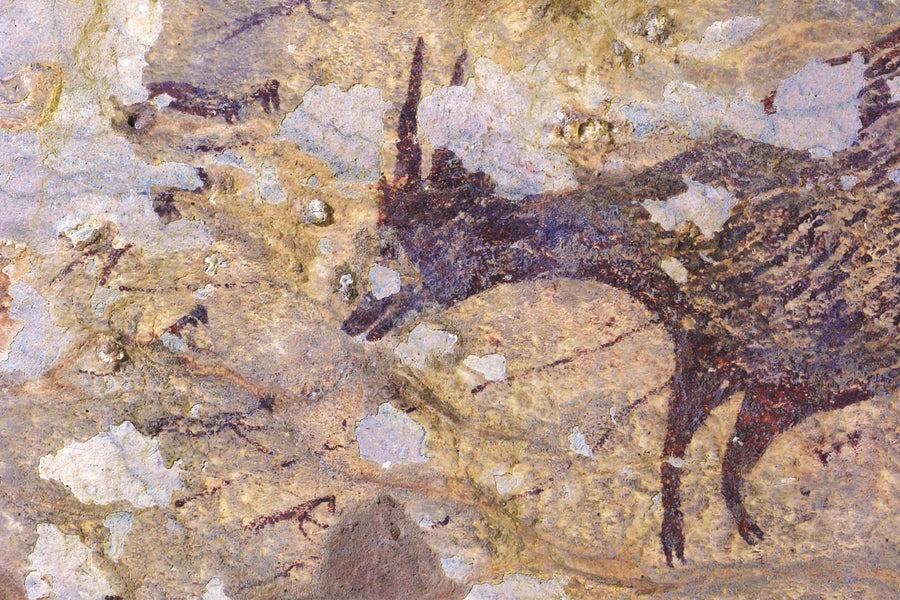
Figures interpreted as therianthropes—mythical beings that are part human, part animal—are said to hunt a small buffalo endemic to the region in one section of the cave painting. Credit: Ratno Sardi
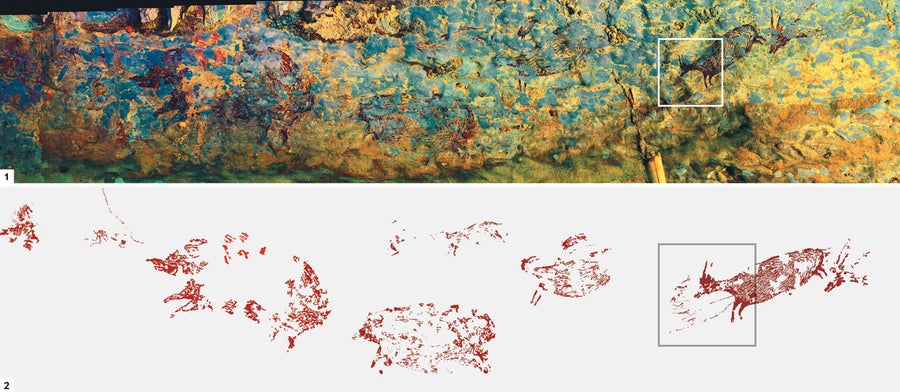
Although some of the imagery has worn away, a photostitched panorama of the full rock art panel (1) and a tracing of the panel (2) show additional therianthropic figures, along with several buffaloes as well as some wild pigs. Samples of mineral deposits that formed atop the figures were dated using uranium-series analysis, which measures the radioactive decay of uranium. The samples yielded minimum dates ranging from 43,900 to 35,100 years ago. Credit: Adhi Agus Oktaviana, Ratno Sardi and Adam Brumm (1, 2)
“Stories and songs are what bring people together,” Nowell remarks. “This panel suggests that this tradition of storytelling goes back [tens of] thousands of years. These stories can be about real events or mythological ones—they can instruct and entertain at the same time.” Although we will probably never know what the Sulawesi tableau was about specifically, she says, “as we collect these stories, these scenes, we begin to develop an understanding of what was meaningful to these particular people at this particular time and place.”
Open Questions
Regarding who painted the figures in Leang Bulu’ Sipong 4: No human skeletal remains have turned up in that cave or at any other site on Sulawesi from that time period. We know human species besides H. sapiens, including Neandertals, made art, although so far it appears to have been exclusively abstract. We also know other human species inhabited Southeast Asia in the not so distant past: Homo floresiensis resided on the Indonesian island of Flores 60,000 years ago, Homo luzonensis lived in the Philippines as recently as 50,000 years ago, and a genetic study has concluded that a late-surviving group of Denisovans may have interbred with H. sapiens in Indonesia or New Guinea just 15,000 years ago. Asked whether one of these other species might have painted the hunting scene, Brumm says, “Given the sophisticated nature of the imagery, our working hypothesis is that modern humans—people with essentially the same cognitive ‘architecture’ as us—made this cave art. It is presumed that these people became established in Sulawesi as part of the initial wave of migration of Homo sapiens into Indonesia at least 70,000 to 50,000 years ago.”
But the sophistication of the imagery is a matter of some dispute. Archaeologist Paul Pettitt of Durham University in England, an expert on early art who was not involved in the new study, points out that although one animal in the group is at least 43,900 years old, most of the other figures are not dated. “‘Scenes’ are very rare in Pleistocene art,” he observes. “If this were in Europe, Africa or North America, it would date to no more than [10,000] years ago.” Pettitt notes that the so-called therianthropes are out of scale with the animals they are said to be hunting. “Could they be unrelated to the animals?” he wonders. Or might they even have been painted at a much later time? “We know that in Europe, ‘painted caves’ were actually decorated in several phases separated by thousands of years,” he says. Geochemical analysis of the pigments involved could be used to establish confidence that the images in Leang Bulu’ Sipong 4 are contemporary.
Pettitt is also not convinced the hunters are therianthropes—or even humanlike. “Some are vague and certainly open to question,” he says. “Even the clearest examples could be quadrupeds,” he adds, remarking on the horizontal depiction of these figures. And the alleged spears are merely “long lines that just pass close to some ‘humans’—hardly weapons in hand,” he says. “So it is an open issue as to whether these represent humans and, if it is a scene, one of hunting.”
Future work may bring resolution. The discovery team’s surveys in the region have turned up many more sites containing figurative paintings that remain to be dated. Perhaps they will furnish new clues to the origins of the image-making, storytelling, myth-inventing modern human mind.
